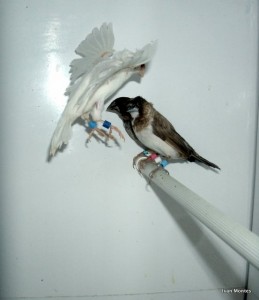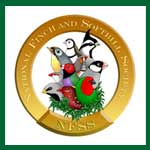The Albino Bengalese
21st June 2012General ArticlesNo CommentsAlbino—Congenital absence of any pigmentation or coloration in a person, animal or
plant, resulting in white skin, hair or feathers and pink eyes in mammals.
Albino in any animal is strikingly beautiful, snow white with bright ruby eyes. The society finch is no exception, solid white, with flesh colored beak and legs, and bright pink eyes.
There are two Albino varieties, the European-autosomal recessive, and the Japanese-autosomal incomplete dominant. The birds I have are of the Euro variety.

Eyes
There is a misconception that albino societies go blind and have eye problems. True albino societies have small vision impairment due to not having any pigment in the eyes. The birds have a hard time when it’s really bright.
The misconception of blindness came from white birds that go blind, as they get older. Most of these birds are white pieds. These birds are prone to eyesight problems, especially cataracts. This happens most often in whites from fawn ancestry.
Identifying
Both Albino varieties are recessive, which means that in order for the albinism to be visually expressed, a bird must get the gene from both parents. If you have a solid white Society, with dark eyes, it’s not an Albino. Solid whites from Fawn ancestry will have red eyes, like an albino, but not as bright.
If you’re still not sure, the best way is to test breed. If you have a red-eyed white bird, breed it to a heavily marked white pied fawn. If any of the babies are white with red eyes, your bird is not a true Albino. The babies would be split, so none should be white with red eyes. If you have more than one of these white red-eyed birds, another test to try is breeding them to each other. If the birds are true albinos all the babies will be albino. In whites from pieds you will get mostly white and a few heavy marked white pied.
Pairing
The best mates for Albinos are large birds of good type. Birds with good feathers are strongly suggested, especially on the face and wings. When you have a white bird with thin feathers it’s easy to see the skin, particularly in the ear area and the bend of the wing. Good feathers are a must when breeding Albinos. It is suggested, that you pair albinos to lighter birds to prevent any smudges. If you use darker colors your white will not be as clean. I personally have not seen this, but I just started.
Chick Rejection
When the chick looks different, some birds may reject it. This is more common in the Inos, because of the lack of pigment in the eyes, beak and mouth markings. I have experienced a little favoritism of normal looking chicks, but only when the Ino chick is out numbered. I had a nest with three albinos and one normal and everything was fine. In the next clutch the tables turned; there were three normals and one Albino. So far, they are doing a good job. I think that is because the first clutch made them more accepting. If you experience favoritism to the darker chicks, I suggest moving the normals to another nest. This may help the pair be more experienced and accepting of the lighter young. It will help in future clutches. It also helps when your pair is older and better fit for parenting.


